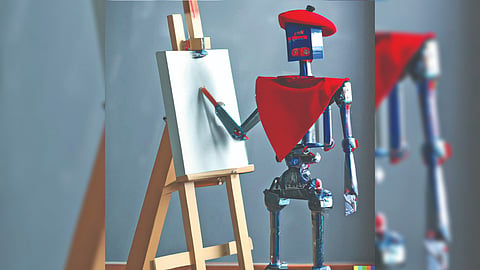

By KEVIN ROOSE
For years, the conventional wisdom among Silicon Valley futurists was that artificial intelligence and automation spelled doom for blue-collar workers whose jobs involved repetitive manual labor. Truck drivers, retail cashiers and warehouse workers would all lose their jobs to robots, they said, while workers in creative fields like art, entertainment and media would be safe. Well, an unexpected thing happened recently: AI entered the creative class. In the past few months, AI-based image generators like DALL-E 2, Midjourney and Stable Diffusion have made it possible for anyone to create unique, hyper-realistic images just by typing a few words into a text box.
These apps, though new, are already astoundingly popular. DALL-E 2, for example, has more than 1.5 million users generating more than two million images every day, while Midjourney’s official Discord server has more than three million members. These programs use what’s known as “generative AI,” a type of AI that was popularised several years ago with the release of text-generating tools like GPT-3 but has since expanded into images, audio and video.
It’s still too early to tell whether this new wave of apps will end up costing artists and illustrators their jobs. What seems clear, though, is that these tools are already being put to use in creative industries. Recently, I spoke to a few creative-class professionals about how they’re using AI-generated art in their jobs. Collin Waldoch, 29, a Brooklyn game designer, recently started using generative AI to create custom art for his online game, Twofer Goofer, which works a bit like a rhyming version of Wordle.
Every day, players are given a clue — like “a set of rhythmic moves while in a half-conscious state” — and are tasked with coming up with a pair of rhyming words that matches the clue. (In this case, “trance dance.”)
Initially, Waldoch planned to hire human artists through the gig-work platform Upwork to illustrate each day’s rhyming word pair. But when he saw the cost — between $50 and $60 per image, plus time for rounds of feedback and edits — he decided to try using AI instead.
He plugged word pairs into Midjourney and DreamStudio, an app based on Stable Diffusion, and tweaked the results until they looked right. Total cost: a few minutes of work, plus a few cents. (DreamStudio charges about a cent per image; Midjourney’s standard membership costs $30 per month for unlimited images.) “I typed in ‘carrot parrot,’ and it spit back a perfect image of a parrot made of carrots,” he said. “That was the immediate ‘aha’ moment.”
Waldoch said he didn’t feel guilty about using AI instead of hiring human artists, because human artists were too expensive to make the game worthwhile. “We wouldn’t have done this” if not for AI, he said.
Roose is a journalist with NYT©2022
The New York Times
Visit news.dtnext.in to explore our interactive epaper!
Download the DT Next app for more exciting features!
Click here for iOS
Click here for Android